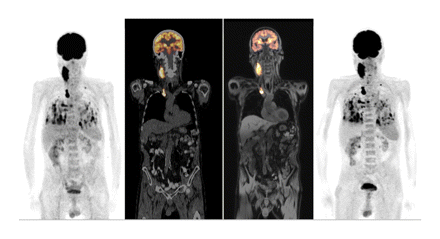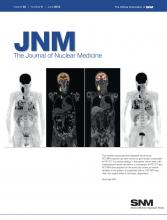Focus on preclinical SPECT: Peterson and Shokouhi offer perspectives on recent innovations in preclinical SPECT instrumentation, including new approaches to collimation, detection, acquisition geometry, calibration, and reconstruction.Page 841
PET/MRI vs. PET/CT in cancer: Drzezga and colleagues look at areas of comparison in clinical performance between PET/CT and integrated whole-body PET/MRI in patients with oncologic diseases.Page 845
PET/CT and cardiac tumors: Rahbar and colleagues explore the diagnostic utility of 18F-FDG PET and the incremental value of an optimized CT score in preoperative assessment of malignancy of cardiac tumors.Page 856

PET/CT in esophageal cancer staging: Barber and colleagues report on incremental information, management impact, and prognostic stratification provided by PET/CT in primary staging of esophageal cancer in a group of patients over an extended follow-up period.Page 864

Therapy evaluation in esophageal cancer: Yanagawa and colleagues compare the PERCIST and RECIST response criteria in patients undergoing neoadjuvant chemotherapy for locally advanced esophageal cancer.Page 872
PET and salivary duct carcinoma: Kim and colleagues assess the utility of 18F-FDG PET and CT in preoperative staging, determination of neck node involvement, and surgical planning for patients with salivary duct carcinoma of the major salivary gland.Page 881
Myocardial flow reserve in CKD: Fukushima and colleagues use 82Rb PET/CT in evaluation of myocardial microcirculation in patients with chronic kidney disease, normal left ventricular function, and no flow-limiting coronary artery disease.Page 887
3D SPECT scar models and ablation: Tian and colleagues assess the value of 201Tl SPECT perfusion imaging to define ventricular myocardial scar areas and characterize myocardial substrate categories of scar, border zone, and normal myocardium.Page 894
18F-FDG and 18F-florbetapir in AD: Newberg and colleagues compare clinical interpretations of the 18F-labeled amyloid tracer florbetapir with those of 18F-FDG PET in healthy volunteers and patients with Alzheimer disease.Page 902

18F-FP-(+)-DTBZ PET of β-cell mass: Normandin and colleagues evaluate this vesicular monoamine transporter type-2 agent for quantitative PET imaging of endogenous pancreatic β-cell mass in healthy individuals and patients with type 1 diabetes mellitus.Page 908

Exercise and muscle 18F-FDG uptake: Lyall and colleagues describe the effects of treadmill exercise on 18F-FDG uptake in skeletal muscles and image quality of torso PET and compare myocardial 18F-FDG uptake with stress myocardial perfusion imaging patterns.Page 917
Radretumab RIT in lymphoma: Erba and colleagues look at lesion uptake, safety, and clinical activity of L19SIP radioimmunotherapy in patients with relapsed lymphoma or multiple myeloma.Page 922

PET/MRI in oncology: Buchbender and colleagues provide an educational overview of early experience with PET/MRI in tumors of the brain, head and neck, chest, abdomen, and pelvis and outline the potential long-term implications for oncologic applications.Page 928

18F-Affibody and HER2-positive metastases: Kramer-Marek and colleagues compare the use of a radiolabeled human epidermal growth factor receptor 2–specific Affibody and 18F-FDG in HER2-expressing pulmonary metastases in a murine model of breast cancer.Page 939
PET with 18F-labeled bombesin analog: Dijkgraaf and colleagues research the gastrin-releasing peptide receptor–targeting potential of a radiolabeled NOTA-conjugated bombesin derivative in small-animal studies.Page 947

Affinity of Affibody molecules: Tolmachev and colleagues evaluate the effects of human epidermal growth factor receptor 2 (HER2) affinity, binding site composition of HER2-binding Affibody molecules, and HER2 density on tumor targeting.Page 953
Radiocopper imaging for Wilson disease: Bahde and colleagues use a 64Cu-labeled PET agent to successfully identify Atp7b-dependent biliary copper excretion, with potential for advancing molecular imaging in Wilson disease.Page 961
Radiofluorinated 5-HT1A agonist: Lemoine and colleagues describe the development of the high-affinity 5-HT1A receptor agonist 18F-F13714 and investigate its utility for PET brain imaging of the serotonin 1A receptor.Page 969
Attenuation correction in PET/MRI: Marshall and colleagues detail a technique to incorporate patient-specific lung density information into MRI-based attenuation maps and compare this with approaches that assume uniform lung density.Page 977
18F-choline biokinetics and dosimetry: Giussani and colleagues detail a compartmental biokinetic and dosimetric model for 18F-choline in the differential diagnosis of prostate cancer and its recurrence.Page 985
PET and iNOS: Herrero and colleagues describe an 18F-labeled inducible form of nitric oxide synthase and report on initial studies and dosimetry in patients after orthotopic heart transplantation.Page 994
ON THE COVER

The recently introduced first integrated whole-body PET/MRI scanner has been shown to give results comparable to PET/CT in a clinical setting. In the patient shown here, with metastasized thyroid carcinoma, a comparison of PET/CT and PET/MRI data acquired on the same day shows an overall similarity in the pattern of suspected lesions. PET/MRI may offer new opportunities in oncologic diagnostics.See page 849.
- © 2012 by the Society of Nuclear Medicine, Inc.







